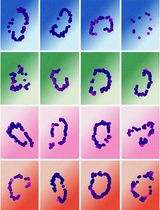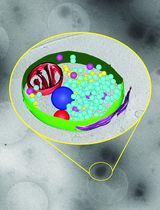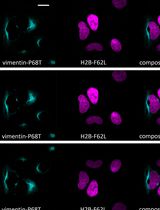- EN - English
- CN - 中文
Identification of Neurons Containing Calcium-Permeable AMPA and Kainate Receptors Using Ca2+ Imaging
利用Ca²⁺成像技术鉴定含钙通透性AMPA受体和海藻酸受体的神经元
发布: 2025年02月05日第15卷第3期 DOI: 10.21769/BioProtoc.5199 浏览次数: 1502
评审: Alessandro DidonnaAnonymous reviewer(s)
Abstract
Calcium-permeable AMPA receptors (CP-AMPARs) and kainate receptors (CP-KARs) play crucial roles in synaptic plasticity and are implicated in various neurological processes. Current methods for identifying neurons expressing these receptors, such as electrophysiological recordings and immunostaining, have limitations in throughput or inability to distinguish functional receptors. This protocol describes a novel approach for the vital identification of neurons containing CP-AMPARs and CP-KARs using calcium imaging. The method involves loading neurons with Fura-2 AM, a calcium-sensitive fluorescent probe, KCl application to identify all neurons, and further addition of specific AMPAR agonists (e.g., 5-fluorowillardiine) in the presence of voltage-gated calcium channel blockers and NMDAR/KAR antagonists to identify CP-AMPAR-containing neurons. CP-KAR-containing neurons are identified using domoic acid applications in the presence and absence of NASPM (a CP-AMPAR antagonist). This technique offers several advantages over existing methods, including the ability to assess large neuronal populations simultaneously, distinguish between different receptor types, and provide functional information about CP-AMPAR and CP-KAR expression in living neurons, making it a valuable tool for studying synaptic plasticity and neurological disorders.
Key features
• The described protocol allows vital identification of neurons containing calcium-permeable AMPA (CP-AMPARs) and kainate receptors (CP-KARs).
• This approach can be combined with other methods, such as electrophysiological recordings or immunostaining.
• The method is fast, reproducible, and allows non-invasive simultaneous identification of numerous CP-AMPAR-/CP-KAR-containing neurons.
• The described protocol can be used for pharmacological screening of different drugs, including neuroprotectors, or investigation of features of CP-AMPAR-/CP-KAR-containing neurons in health and disease.
Keywords: Calcium-permeable AMPA receptors (钙通透性AMPA受体)Background
Glutamate is a primary excitatory neurotransmitter in the mammalian nervous system that activates various types of glutamate receptors, including AMPA receptors (AMPARs). A subset of AMPARs, known as calcium-permeable AMPA receptors (CP-AMPARs), play a crucial role in synaptic plasticity mechanisms such as long-term potentiation (LTP) and depression (LTD) [1,2]. In addition to Na+ and K+ conductance, these receptors are permeable for Ca2+ ions due to either the absence of the GluA2 subunit or the presence of the unedited GluA2 subunits [3].
Although CP-AMPARs are involved in normal brain functioning, they are also associated with various pathologies [4], including neurodegenerative diseases such as Alzheimer’s [5,6] and Parkinson’s diseases [7,8]. CP-AMPAR surface expression is dynamically regulated in response to changes in synaptic activity: while a weak stimulus promotes CP-AMPAR incorporation into the plasma membrane, stronger stimulation favors calcium-impermeable AMPARs [4]. This dynamic regulation underlies their importance in both Hebbian and non-Hebbian forms of plasticity across different brain regions.
Despite CP-AMPARs' significance in synaptic processes, our understanding of their role and the neurons expressing them remains poorly studied. This knowledge gap is partly due to the challenges associated with identifying CP-AMPAR-containing neurons. Current methods for detecting these receptors have notable limitations. Electrophysiological techniques, such as current-voltage relationship analysis and the use of polyamine antagonists, can identify synapses with CP-AMPARs and study their functions in individual neurons [9]. However, these approaches are labor-intensive and limited in their ability to assess large neuronal populations simultaneously. Additionally, some antagonists used in these studies may also affect kainate receptors, potentially confounding results [10]. Immunostaining methods, typically using anti-GluA2 antibodies, allow the evaluation of CP-AMPAR expression across larger groups of neurons [11,12]. However, this approach cannot distinguish between edited and unedited GluA2 subunits, which is crucial as unedited GluA2-containing AMPARs are also calcium-permeable. While most GluA2 subunits in the adult brain are edited, thus resulting in the formation of calcium-impermeable AMPARs, editing levels can change under certain pathological conditions, potentially leading to inaccurate conclusions about CP-AMPAR expression.
To address these limitations, we have developed a novel protocol based on vital fluorescent calcium imaging. This method offers several advantages over existing techniques:
1. It enables the identification of neurons expressing both GluA2-lacking CP-AMPARs and those containing unedited GluA2 subunits.
2. The approach visualizes neurons with a significant number of CP-AMPARs sufficient to induce detectable somatic calcium influx.
3. It facilitates the evaluation of changes in CP-AMPAR expression at the population level, allowing for the study of various experimental manipulations in models of brain pathologies.
4. The technique is less labor-intensive than electrophysiological recordings and provides more functional information than immunostaining alone.
Our calcium imaging-based protocol for identifying CP-AMPAR-containing neurons offers a valuable tool for advancing research in synaptic plasticity, neuronal development, and neuropathology. By bridging the gap between single-cell electrophysiology and population-level immunostaining, this method provides a more comprehensive understanding of CP-AMPAR distribution and function in the nervous system. We believe that it will shed light on the roles of these receptors in both physiological and pathological processes, opening new avenues for research into neurological disorders and potential therapeutic interventions.
Materials and reagents
Biological materials
1. Postnatal (P0-2) Wistar male rats (branch of the M.M. Shemyakin and Yu.A. Ovchinnikov Institute of Bioorganic Chemistry of the Russian Academy of Sciences)
Reagents
1. Poly(ethyleneimine) solution 50% w/v in water (Sigma-Aldrich, catalog number: P3143); stock and working solutions are stored at 4 °C
2. (±)-Verapamil hydrochloride (Sigma-Aldrich, catalog number: V4629); powder is stored at 4 °C, whereas aliquots are stored at -20 °C
3. Penicillin–streptomycin 100× solution (Sigma-Aldrich, catalog number: P4333); aliquots stored at -20 °C
4. L-Glutamine (Sigma-Aldrich, catalog number: G85402); powder is stored at 4 °C, whereas aliquots are stored at -20 °C
5. (S)-5-Fluorowillardiine (Sigma-Aldrich, catalog number: F2417); powder and aliquots are stored at -20 °C
6. Neurobasal-A medium (Life Technologies, catalog number: 10888022); stored at 4 °C.
7. 50× B27 supplement (Life Technologies, catalog number: 17504044); aliquots of stock solution (we recommend using 1 mL aliquots) are stored at -20 °C
8. Trypsin 2.5% (Life Technologies, catalog number: 15090046); stock solution and working solution aliquots are stored at -20 °C
9. Fura-2 AM (Molecular Probes, catalog number: F1221); undissolved dye and aliquots of the stock solution are stored at -20 °C; the stock solution should be bubbled with argon (recommended) or nitrogen and tightly sealed before freezing
10. Bicuculline (Cayman Chemical, catalog number: 11727); the powder is stored at 4 °C, whereas aliquots are stored at -20 °C
11. UBP310 (Tocris Bioscience, catalog number: 3621); powder and aliquots are stored at -20 °C
12. Domoic acid (Tocris Bioscience, catalog number: 0269); powder and aliquots are stored at -20 °C
13. NASPM trihydrochloride (Tocris Bioscience, catalog number: 2766); powder and aliquots are stored at -20 °C
14. ATPA [(RS)-2-Amino-3-(3-hydroxy-5-tert-butylisoxazol-4-yl)propanoic acid] (Tocris Bioscience, catalog number: 1107); powder and aliquots are stored at -20 °C
15. D-AP5 (D-2-Amino-5-phosphopentanoic acid) (Alomone Labs, catalog number: D-145); powder and aliquots are stored at -20 °C
16. HEPES [4-(2-hydroxyethyl)-1-piperazineethanesulfonic acid] (AppliChem Panreac, catalog number: A3268); room temperature storage
17. Sodium chloride (NaCl) (USP, BP, Ph. Eur., JP) pure, pharma grade (AppliChem Panreac, catalog number: 141659); room temperature storage
18. Sodium phosphate dibasic (Na2HPO4) (Sigma-Aldrich, catalog number: S5136); room temperature storage
19. Potassium phosphate monobasic (KH2PO4) (Sigma-Aldrich, catalog number: P5156); room temperature storage
20. Potassium chloride (KCl) (USP, BP, Ph. Eur.) pharma grade (AppliChem Panreac, catalog number: 191494); room temperature storage
21. Sodium bicarbonate (NaHCO3) (Sigma-Aldrich, catalog number: P5761); room temperature storage
22. D-(+)-Glucose (Sigma-Aldrich, catalog number: G7021); room temperature storage
23. EDTA [2,2',2'',2'''-(Ethane-1,2-diyldinitrilo)tetraacetic acid] (AppliChem Panreac, catalog number: A5097); room temperature storage
24. Magnesium sulfate 7-hydrate (USP, BP, Ph. Eur.) pure, pharma grade (MgSO4·7H2O) (AppliChem Panreac, catalog number: 141404); room temperature storage
25. Calcium chloride (CaCl2) 1 M in H2O (Sigma-Aldrich, catalog number: 21115); store at 4 °C
26. Isoflurane (IsoNic) (Vetoquinol, 1,000 mg/g); store at 4 °C (the cap of the opened vial should be sealed with Parafilm M or another appropriate material)
27. Dimethyl sulfoxide (DMSO) (USP, BP, Ph. Eur.) (AppliChem Panreac, catalog number: 191954), store at room temperature in the dark
28. Trypan blue (Sigma-Aldrich, catalog number: 302643)
Solutions
1. Polyethyleneimine (PEI) solution (see Recipes)
2. Versene solution (see Recipes)
3. Hank’s balanced salt solution (HBSS) (see Recipes)
4. Neuron-glial cell culture growth medium (see Recipes)
5. Trypan blue 0.4% (w/v) solution (see Recipes)
Recipes
1. Polyethyleneimine (PEI) solution 1 mg/mL
Stock polyethyleneimine solution (Mn ~60,000; Mw 750,000) is jelly-like. Weigh the stock solution in a glass beaker, applying the substance on the beaker walls using a spatula. After weighing, add the required volume of double-distilled water and stir the solution for at least 30 min at room temperature using a magnetic stirrer. Then, filter the obtained PEI solution through a 0.22 μm membrane syringe filter for sterilization. Store the working solution at 4 °C and avoid freezing.
2. Versene solution
| Reagent | Final concentration |
|---|---|
| NaCl | 137 mM |
| KCl | 2.7 mM |
| KH2PO4 | 2 mM |
Na2HPO4 EDTA | 8 mM 0.6 mM |
After EDTA addition, the solution should be heated to 40–50 °C at constant stirring to dissolve this chelator. To obtain a sterile Versen solution, it should be filtered through a 0.22 μm sterile syringe filter after dilution of all components. Double-distilled water is used to prepare the Versene solution. The prepared solution can be stored at room temperature or 4 °C.
3. Hank’s balanced salt solution
| Reagent | Final concentration |
| NaCl | 137 mM |
| KCl | 3 mM |
| Na2HPO4 | 0.35 mM |
| KH2PO4 | 1.25 mM |
| NaHCO3 | 4.2 mM |
| D-(+)-Glucose | 10 mM |
| HEPES | 10 mM |
| MgSO4·7H2O | 0.8 mM |
| CaCl2 | 1.4 mM |
Adjust pH to 7.35 using 10 M NaOH (the temperature of the solution during the pH adjustment must correspond to the temperature at which imaging experiments will be performed; in our studies, we perform all experiments at 28 °C). Since the neurons are sensitive to the pH of the extracellular solution, check the pH of HBSS before the experiments if HBSS is stored at 4 °C or more than one day at room temperature (slight alkalization is observed).
4. Neuron-glial cell culture growth medium
| Reagent | Final concentration |
|---|---|
| Neurobasal A-medium | n/a |
| 50× B27 supplement | 2% (v/v) |
| L-glutamine | 0.5 mM |
| 100× Penicillin-streptomycin | 1% (v/v) |
L-glutamine is unstable in aqueous solutions. Add L-glutamine immediately before the cell culture preparation or use stable analogs. Due to the instability of some components, we recommended preparing small portions of neuron-glial cell culture growth medium (50–100 mL) and storing them at 4 °C for no more than 1 week.
5. Trypan blue 0.4% (w/v) solution
Trypan blue 0.4% working solution is prepared by dissolving the weighed powder in phosphate-buffered saline (PBS). PBS composition is listed below (pH 7.35). Before the application, the solution was filtered through a syringe filter with a pore size of 0.22 μm to remove undissolved aggregates.
| Reagent | Final concentration |
|---|---|
| NaCl | 137 mM |
| KCl | 2.7 mM |
| KH2PO4 | 2 mM |
| Na2HPO4 | 8 mM |
Laboratory supplies
1. Cell culture dishes 35 mm (SPL Lifesciences, catalog number: 11035)
2. Cell culture dishes 60 mm (SPL Lifesciences, catalog number: 11060)
3. Cell culture dishes 150 mm (SPL Lifesciences, catalog number: 10151)
4. Sterile microcentrifuge tube 1.5 mL (GenFollower, catalog number MCTB015)
5. Sterile centrifuge tubes 50 mL (GenFollower, catalog number B-2SCTB50YE)
6. Low-retention pipette tips 200 μL (GenFollower, catalog number E-FTR200-L-S)
7. Low-retention pipette tips 1000 μL (GenFollower, catalog number E-FTR1000-L-S)
8. Round cover glasses 25 mm (VWR, catalog number 630-2122)
9. Syringe filter 0.22 μm (Membrane Solutions, catalog number MS-SFPES025022SI)
10. Cover glasses 24 × 24 (Minimed, catalog number 12003316)
Equipment
1. Thermoshaker (Biosan, model: TS-100, catalog number BS-010120-AAI) with thermoblock SC-18/02 (Biosan, catalog number BS-010120-CK)
2. High-speed centrifuge (DLab, model: D2012, catalog number 9032002121)
3. Laminar flow hood (Lamsystems, model: BMB-II-"Laminar-S."-1,2 NEOTERIC, catalog number 2E-B.001-12)
4. Trinocular inverted microscope (Nikon, model: Eclipse TS100)
5. Stereo microscope (Leica Microsystems, model: EZ4D)
6. CO2 incubator (N-Biotek, model: NB-203XL)
7. Epifluorescent inverted microscope (Leica Microsystems, DMI 6000B) with CCD-camera (Hammamatsu, model: 9100C) and illuminator (Leica Microsystems, model: EL6000)
8. Analytical scale (Ohaus, model: Explorer EX324)
9. pH meter (Mettler Tolledo, model: S20 SevenEasy)
10. Magnetic stirrer with a hot plate (Biosan, model: MSH-300)
11. Bidistiller (GFL, model: 2104)
12. Multi-output animal anesthesia machine (RWD Life Science, model: R550)
13. Drying and heating chamber with natural convection (Binder Inc., model: ED23)
14. Neubauer chamber (JVLAB, catalog number: 1103)
15. Instruments for tissue extraction and preparation: dental curved tweezers 150 mm (catalog number: 10-94), dental spatula (catalog number: 10-97), and medical blunt-pointed straight scissors (catalog number: 4-26) from Mozhaisk Medical Supplies Factory; curved scissors (catalog number: ТН-06-041-11,3) and scalpel (catalog number: TC-02-051-15) from Tumbotino Medical Supplies Factory; sharp-pointed straight (catalog number: ST-14) and curved (catalog number: ST-15) tweezers from NAGARAKU, Shanghai Xijian Electronic Technology Co., Ltd.
Software and datasets
1. ImageJ v1.53s (https://imagej.net/ij/, May 2022)
2. OriginLab Pro 2016 version b9.3.226 (commercially available software, license required; other free software for plot creation can be used as an alternative, October 2015)
Procedure
文章信息
稿件历史记录
提交日期: Oct 7, 2024
接收日期: Dec 10, 2024
在线发布日期: Jan 9, 2025
出版日期: Feb 5, 2025
版权信息
© 2025 The Author(s); This is an open access article under the CC BY-NC license (https://creativecommons.org/licenses/by-nc/4.0/).
如何引用
Gaidin, S. G., Kosenkov, A. M., Zinchenko, V. P., Kairat, B. K., Malibayeva, A. E. and Tuleukhanov, S. T. (2025). Identification of Neurons Containing Calcium-Permeable AMPA and Kainate Receptors Using Ca2+ Imaging. Bio-protocol 15(3): e5199. DOI: 10.21769/BioProtoc.5199.
分类
神经科学 > 神经解剖学和神经环路 > 荧光成像
神经科学 > 细胞机理 > 突触生理学
细胞生物学 > 细胞成像 > 荧光
您对这篇实验方法有问题吗?
在此处发布您的问题,我们将邀请本文作者来回答。同时,我们会将您的问题发布到Bio-protocol Exchange,以便寻求社区成员的帮助。
提问指南
+ 问题描述
写下详细的问题描述,包括所有有助于他人回答您问题的信息(例如实验过程、条件和相关图像等)。
Share
Bluesky
X
Copy link












